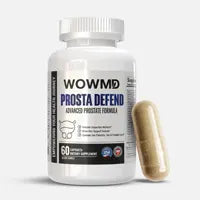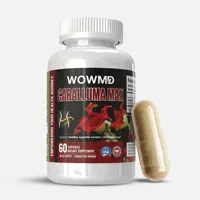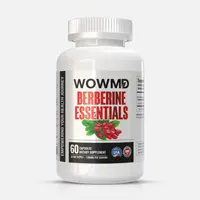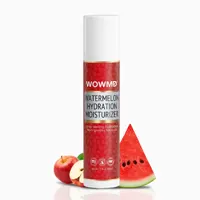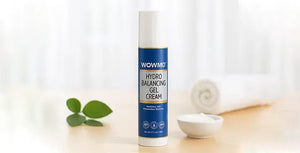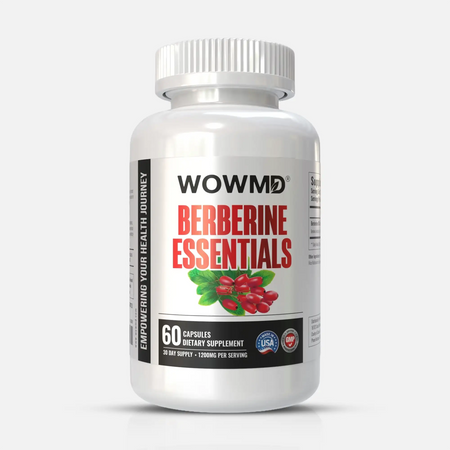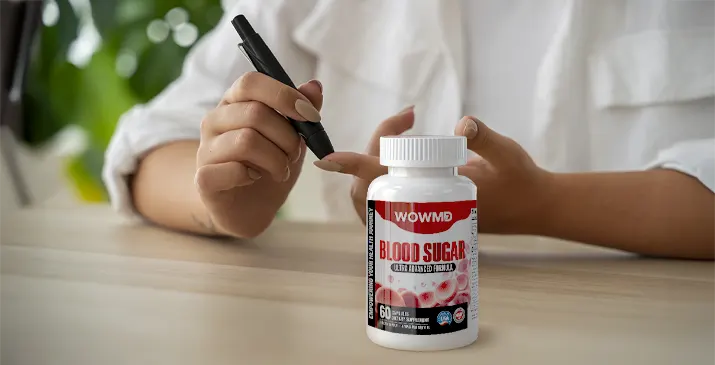
What to Do When Blood Sugar Is High?
Learn practical strategies to manage high blood sugar levels and improve overall health with natural remedies and lifestyle changes.
Advertiser Disclosure: WOWMD independently vets all recommended products. If you purchase a featured product, we may be compensated. Learn why you can trust us.

You have more control over your blood sugar than you might think. High blood glucose levels can happen for many reasons, but with the right knowledge and tools, you can take action to bring them down and protect your long-term health.
This guide is here to empower you whether you’re newly diagnosed or looking to fine-tune your blood sugar management, with practical tips for recognizing high blood sugar, responding in the moment, and building habits that support lasting balance.
According to the American Diabetes Association, a normal blood sugar level is defined as a fasting plasma glucose of less than 100mg/dL.[1] Hyperglycemia, or high blood glucose levels would be anything above that level.
Hyperglycemia can be caused by a variety of different reasons. Most commonly, hyperglycemia is associated with a prediabetes or diabetes diagnosis. However, some other acute medical conditions can also create occurrences of hyperglycemia.
If people have high blood glucose levels for extended periods of time, they may be at increased risk of vision problems or other complications with the heart or kidneys. In some cases, hyperglycemia can be particularly dangerous, including diabetic ketoacidosis (DKA) or hyperosmolar hyperglycemia state (HHS).
Diabetic ketoacidosis occurs when insulin is not able to adequately transport glucose from the bloodstream into the cells.[2] This creates very high blood sugar levels. But, since the cells are still looking for energy, the body begins to break down fat for energy, but this creates a buildup of ketones in the blood. The high levels of ketones create an acidic environment.
Hyperosmolar hyperglycemic state is when high blood glucose levels lead to severe dehydration and very concentrated blood.
There are a few early symptoms of DKA to look out for:
- Increased thirst
- Increased urination
Balance your glucose naturally with WOWMD Blood Sugar Ultra Advanced Formula - Shop Now
TL;DR
- Q: How can I lower blood sugar fast? Drink water, light walk, follow insulin plan.
- When to call a doctor? If levels stay >250 mg/dL or symptoms like fruity breath, nausea.
- Natural remedies? Apple cider vinegar, cinnamon, probiotics.
- Long-term? Balanced diet, regular exercise, stress management, supplements.
Recognizing High Blood Sugar
| Symptom | Why It Happens | When to Act |
|---|---|---|
| Excessive thirst | Body flushes glucose through urine | If persistent |
| Frequent urination | Kidneys overworking | If hourly or disrupts sleep |
| Blurred vision | High sugar affects eye fluid balances | Seek care if sudden |
| Fatigue/headache | Cells not getting glucose energy | If daily & worsening |
When people are in a hyperglycemic state or have a diagnosis of diabetes, there are some common symptoms they may experience. These symptoms include increased thirst, frequent urination, blurred vision, and headaches.
Of course, some people may experience no symptoms at all, so it is important for people to always follow the recommendations of their doctor when it comes to frequency of blood sugar testing.
Blood Sugar Thresholds:
According to the US Centers for Disease Control and Prevention (CDC), people should aim for the following blood sugar levels to help avoid unwanted side effects of hyperglycemia.[3]
- Before a meal: 80-130 mg/dL
- 2 hours after the start of a meal: less than 180 mg/dL
It is imperative that people follow regular monitoring of their glucometers or continuous glucose monitor (CGM) in order to best monitor their treatment plan. Without knowing your numbers it would be difficult to track your treatment plan and goals.
Regular monitoring would allow you to know how certain foods, activities, or exercises affect your blood glucose levels.
Dr. David Ludwig, an endocrinologist and researcher at Boston Children’s Hospital and author of "Always Hungry?" says that "Maintaining stable blood sugar levels is crucial not only for managing diabetes but for overall health and longevity. Lifestyle changes, including a balanced diet, regular exercise, and stress management, can significantly improve blood glucose control."
Track smarter — pair your monitoring with WOWMD Blood Sugar Ultra for daily support - Shop Now.
Immediate Actions to Lower Blood Sugar
 Immediate Actions to Lower Blood Sugar
Immediate Actions to Lower Blood Sugar
Rapid-Acting Insulin:
Doctors may prescribe rapid-acting insulin to help lower blood sugar levels and keep them within a normal range. Some examples of rapid-acting insulin include humalog, admelog, or novorapid.
Typically,rapid-acting insulin is taken by people with diabetes at mealtimes to help prevent a spike in blood sugars from meals.[4]
It is important that rapid acting insulin is properly calculated and timed. If someone takes the insulin too early before a meal time, or in too large of a dose, they may develop hypoglycemia, when blood glucose levels fall too low.
Physical Activity:
Engaging in physical activity can help people manage blood sugar levels. Studies show that maintaining the longer duration of low-intensity PA throughout the day could be more beneficial for reducing inflammation and improving insulin resistance.[5]
Therefore, low-intensity exercises such as walking for long periods may be more beneficial in improving insulin sensitivity than higher intensity exercises.
Hydration:
Ensuring adequate hydration is also important for blood sugar management. When someone is dehydrated, the blood sugar levels appear more elevated because the sugar concentration is higher in the blood.
Adequate hydration can help ensure blood sugar is not too concentrated. Additionally, maintaining hydration can help the kidneys properly flush out extra glucose.
In this video, Audrey shares her personal experience with WOWMD Blood Sugar Ultra Advanced Formula, revealing how it helped her overcome sugar cravings, reduce energy crashes, and support healthy blood sugar levels naturally.
WOWMD Blood Sugar Ultra Advanced Formula combines chromium, banaba, and herbs for balanced glucose — Shop Now
Dietary Adjustments:
High glycemic foods, such as sweets, candies, desserts, potatoes, or white rice create a spike in blood sugar levels. Choosing foods that are rich in fiber, or consumed in combination with proteins or healthy fats, can help to prevent blood sugar spikes.
Try Apple Cider Vinegar
Drinking apple cider vinegar before meals may help lower blood sugar and improve insulin sensitivity. Mix 1-2 tablespoons with water and drink it before eating. However, this should be used alongside, not instead of, medical treatments.
Add Cinnamon and Other Spices
Spices like cinnamon may help lower fasting blood sugar and improve insulin sensitivity. Adding 1-6 grams of cinnamon daily could be beneficial. Other helpful spices include fenugreek, turmeric, and ginger.
Include Probiotics
Probiotics may help manage diabetes by improving how the body processes sugar.[6] Foods like yogurt, kefir, sauerkraut, and kimchi contain natural probiotics that support better blood sugar control.
Did you know?
- DYK? A 15–30 min walk after meals lowers glucose better than high-intensity workouts.
- DYK? Even mild dehydration spikes blood sugar by concentrating glucose in blood.
- DYK? Cinnamon (1–6 g/day) can lower fasting glucose up to 10%.
- DYK? Stress hormones like cortisol raise blood sugar levels.
Take control of your blood sugar today – order WOWMD Blood Sugar Ultra Advanced now!
Long-Term Strategies for Blood Sugar Management
 Long-Term Strategies for Blood Sugar Management
Long-Term Strategies for Blood Sugar Management
Balanced Diet:
A healthy diet can help promote long-term blood sugar management. Consuming a diet rich in whole foods, fiber-rich choices, lean protein, and healthy fats can help to improve blood sugar levels and promote healthy weight loss.
- Fiber helps to slow the digestion of foods, which in turn helps to prevent spikes in blood sugar. Similarly, when consuming carbohydrates in combination with lean protein or healthy fats, digestion slows, which helps to slow the absorption of sugars from the digestive system into the bloodstream.
- When digestion is slowed and sugars enter the bloodstream more slowly, blood glucose levels are more stable and are able to be maintained within the normal range.
- Consuming a balanced diet can also help to maintain a healthy weight, which has been shown to reduce the risk of developing insulin resistance.
Regular Exercise:
Aerobic exercise helps manage blood sugar by increasing insulin sensitivity and allowing muscles to use glucose more effectively during and after activity. Resistance training builds muscle mass, which improves glucose uptake and storage, further supporting blood sugar control.
Building muscle mass can also help to optimize metabolism and manage weight.
Medication Adherence:
Taking prescriptions as prescribed is essential for effective blood sugar management, as these medications help regulate glucose levels and prevent complications. Skipping doses, taking incorrect amounts, or stopping medication without a doctor's guidance can lead to dangerous spikes or drops in blood sugar.
Consistent use ensures the medication works properly and supports overall diabetes control.
- Taking supplements may help support blood sugar management, especially when used alongside prescribed treatments and healthy lifestyle habits. Certain best blood sugar supplements, such as chromium, magnesium, or alpha-lipoic acid, have shown potential in improving insulin sensitivity or glucose metabolism.
- However, it’s important to consult a healthcare provider before starting any supplement, as they can interact with medications or affect blood sugar levels unpredictably.
- Supplements such as WOWMD Blood Sugar Ultra Advanced Formula, contain micronutrients that may help to manage diabetes and improve blood sugar levels. People consuming this supplement generally find improvement in insulin sensitivity, improved metabolism and energy levels, and sustained blood sugar control.
Stress Management:
Managing stress is important for blood sugar control because stress hormones like cortisol can raise blood glucose levels. Techniques such as deep breathing, meditation, or regular physical activity can help lower stress and stabilize blood sugar.
Reducing stress also supports better sleep and healthier lifestyle choices, both of which contribute to more consistent glucose levels.
✨Real People. Real Results.
Join thousands who trust WOWMD Blood Sugar Ultra to support balanced blood sugar and sustained energy.
💬"I feel more energized throughout the day and my sugar cravings are under control!" – Thomas J., California
💬"Blood Sugar Ultra keeps my levels stable with fewer spikes. I feel balanced and less drained." – Andrea C., New York
💬"These capsules have helped improve my metabolism and maintain steady energy. I definitely recommend them!" – Rebecca H., Texas
💬"WOWMD Blood Sugar Ultra really supports my overall wellness. My blood sugar and energy levels are finally consistent." – James, Florida
Join thousands already improving their energy and metabolism – shop WOWMD now
When to Seek Medical Attention
You should seek medical attention for hyperglycemia if your blood sugar stays elevated despite taking medication or making lifestyle changes. Warning signs may include frequent urination, extreme thirst, fatigue, and blurry vision.
Symptoms consistent with Diabetic Ketoacidosis or Hyperosmolar Hyperglycemic State would require immediate medical intervention.[7]
If you experience nausea, vomiting, abdominal pain, fruity-smelling breath, or difficulty breathing, these may be signs of diabetic ketoacidosis (DKA) which is considered a medical emergency. In these cases, it is important to seek immediate medical care, as untreated DKA can be life-threatening.
“Seek urgent care if blood sugar >250 mg/dL with nausea, fruity breath, or trouble breathing.”
Preventive Measures
Preventive measures for hyperglycemia include regular blood sugar monitoring to detect and address rising levels early. Consistently tracking glucose helps individuals recognize patterns and adjust their diet, activity, or medication as needed.
Ongoing diabetes education is also essential, as it empowers patients to make informed decisions about their care and understand the effects of food, exercise, stress, and medication on blood sugar.
Regular follow-up with healthcare providers ensures that treatment plans remain effective and are adjusted based on individual needs and goals. Together, these steps help reduce the risk of complications and support long-term blood sugar control.
Many people who struggle with high blood sugar levels also find benefit in keeping food diaries. Keeping a log of all foods consumed can help to target what types and amounts of foods can cause elevated blood sugar levels. When you know what is elevating blood sugars, it can become easier to get them under control.
Quick Blood Sugar Support Checklist
✅Test & track: Know your numbers with a glucometer or CGM.
✅Walk it off: Light exercise after meals helps bring levels down fast.
✅Hydrate well: Water helps flush out excess glucose.
✅Eat smart: Choose fiber, protein, and healthy fats over refined carbs.
✅Natural boost: Cinnamon, apple cider vinegar, or probiotics may support balance.
✅Stay consistent: Take your meds or supplements as directed.
Support healthy blood sugar the natural way – order WOWMD Blood Sugar Ultra Advanced Formula before stock runs out.
Conclusion
Taking control of high blood sugar starts with understanding what affects it—and being prepared to act when levels rise. Managing hyperglycemia is achievable through a combination of healthy eating, regular physical activity, lifestyle adjustments, and, when necessary, medication or supplements.
Knowing how to respond quickly can help prevent complications and support better long-term health.
Even implementing just one of the strategies outlined above can lead to meaningful improvements in blood sugar control. Remember, it’s about progress and not perfection. Every small step you take is a step toward greater stability and well-being.
Take control now — Shop WOWMD Blood Sugar Ultra Advanced Formula risk-free.
Frequently Asked Questions
Our Top Picks
Green Coffee Bean Extract With GCA
4.8 / 5.0
(116)116 total reviews
About WOWMD Staff
See Our Editorial Policy > Meet Our Health Expert NetworkThe WOWMD Staff category features a diverse team of writers, each bringing specialized knowledge in areas such as nutrition, fitness, wellness, and more. Articles in this category benefit from insights provided by multiple experts. All content is peer-reviewed and regularly updated to ensure compliance with our editorial standards.
You May Also Like
Popular Stories
- The Best Beef Tallow Products for Radiant Skin: A 2026 Guide
- Holy Basil : Ayurveda’s Herb for Balance, Immunity & Everyday Calm
- Best Gel Moisturizers for Hydration & Skin Care in 2026
- 7 Best Effective Supplements for Improving Bladder and Prostate Health in 2026
- 4 Best Cooling Gels for Skin and Body: Instant Refreshment and Relief
- 4 Best Hyaluronic Acid Serums for Skin Hydration - Tested & Reviewed
References
WOWMD follows strict sourcing guidelines to ensure the accuracy of its content, outlined in our editorial policy. We use only trustworthy sources, including peer-reviewed studies, qualified experts, and information from top institutions.
- Understanding Diabetes Diagnosis: https://diabetes.org/about-diabetes/diagnosis
- Diabetic Ketoacidosis: https://www.cdc.gov/diabetes/about/diabetic-ketoacidosis.html
- Manage Blood Sugar: https://www.cdc.gov/diabetes/treatment/index.html
- About rapid-acting insulin: https://www.nhs.uk/medicines/insulin/rapid-acting-insulin/about-rapid-acting-insulin/
- Increasing the Duration of Light Physical Activity Ameliorates Insulin Resistance Syndrome in Metabolically Healthy Obese Adults: https://pmc.ncbi.nlm.nih.gov/articles/PMC7290973/
- Hyperosmolar Hyperglycemic State (HHS):https://my.clevelandclinic.org/health/diseases/21147-hyperosmolar-hyperglycemic-state
Evidence Based Research
This WOWMD content has been reviewed, as well as checked for facts, so as to guarantee the best possible accuracy.
We follow a strict editorial policy, especially related to the sources we use. Our articles are resourced from reputable online pages, with research drawn from academic institutions and peer-reviewed studies. You can click on the numbers in the parentheses (1, 2, etc.) and check out those references.
The feedback form on this page can be used to report content that is not accurate, up-to-date or questionable in any manner.
We do NOT intend for the information presented through our articles to replace the medical relationship with a qualified physician, nor does it represent specialized advice.


 Alpha Man Power Pack
Alpha Man Power Pack All-Day Fat Burn Trio
All-Day Fat Burn Trio Better Immunity Bundle
Better Immunity Bundle  Calm & Sleep Duo
Calm & Sleep Duo Cognitive Health & Vision Combo
Cognitive Health & Vision Combo Complete Weight Loss Bundle
Complete Weight Loss Bundle Core Vitality Trio
Core Vitality Trio Energy Booster Combo
Energy Booster Combo Focus Fuel Trio
Focus Fuel Trio Glow & Balance Duo
Glow & Balance Duo Health Balance Trio
Health Balance Trio Heart Care Bundle
Heart Care Bundle Joint Health Support Combo
Joint Health Support Combo Men's Immunity & Prostate Health Bundle
Men's Immunity & Prostate Health Bundle Metabolism Boost Duo
Metabolism Boost Duo Natural Skin Care Bundle
Natural Skin Care Bundle Peak Performance Duo
Peak Performance Duo Relax & Recharge Duo
Relax & Recharge Duo Skin Detoxification Bundle
Skin Detoxification Bundle Smart Energy Trio
Smart Energy Trio Stress + Energy + Wellness Combo
Stress + Energy + Wellness Combo  Total Burn Ignite Trio
Total Burn Ignite Trio Total Harmony Pack
Total Harmony Pack Workout Supplements Combo
Workout Supplements Combo
